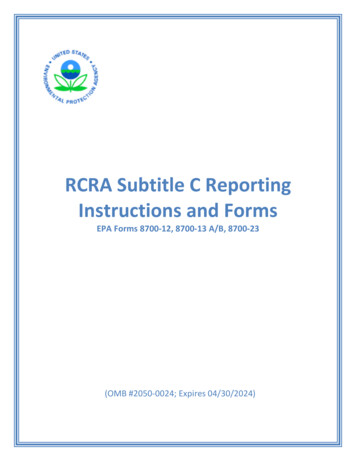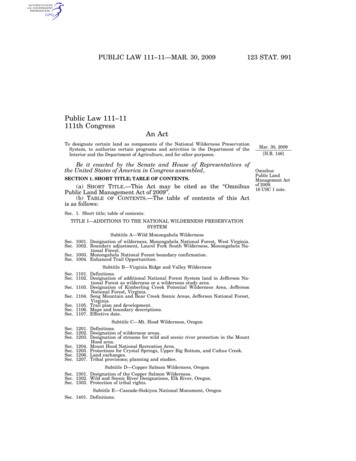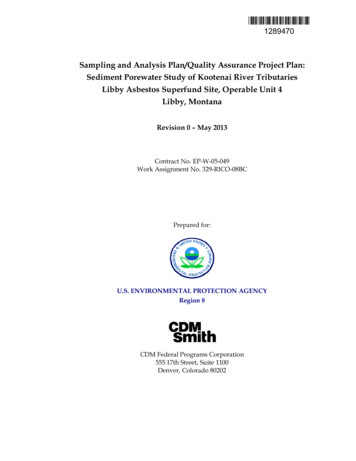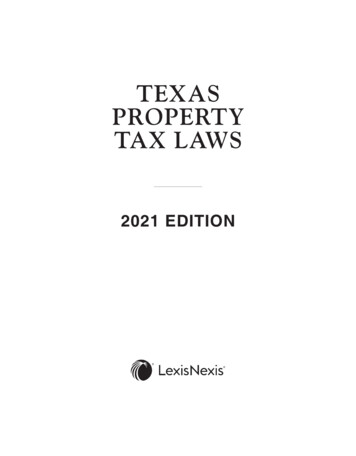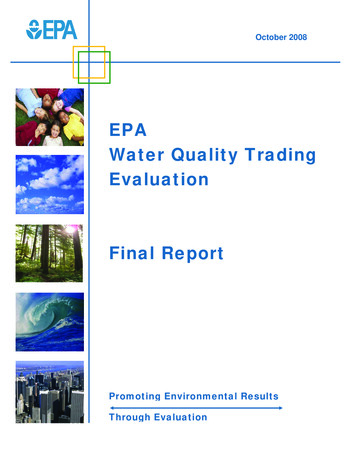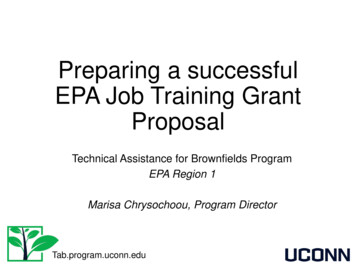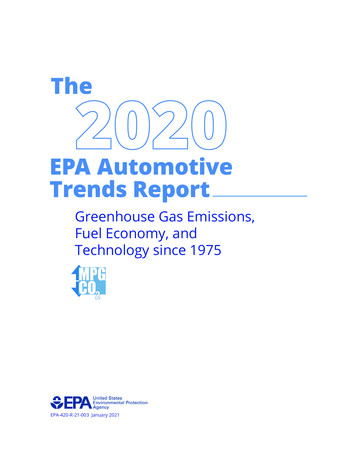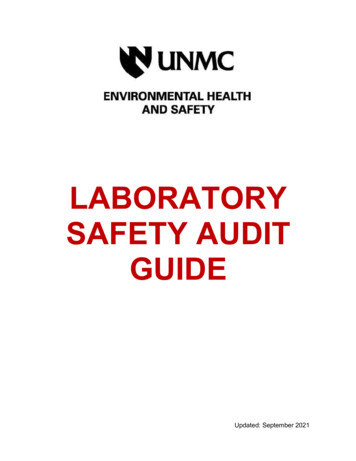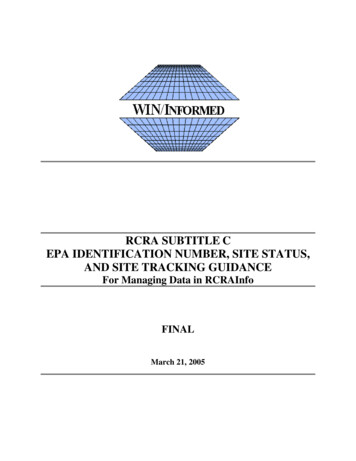
Transcription
RCRA SUBTITLE CEPA IDENTIFICATION NUMBER, SITE STATUS,AND SITE TRACKING GUIDANCEFor Managing Data in RCRAInfoFINALMarch 21, 2005
TABLE OF CONTENTS1.3.1 Background . 31.3.2 How to Designate a Site as Active or Inactive in RCRAInfo . 41.3.3 Why is it Important to Designate Active and Inactive Sites. 4A. Active Sites . 4B. Inactive Sites . 52 - DEFINITIONS . 6Relevant Definitions from 40 CFR 260.10 . 6EPA Identification Number . 6Facility . 6Generator . 6Individual Generation Site . 6On-site . 6Operator . 6Owner. 6Person . 6Transporter . 6Universal Waste . 6Universal Waste Handler . 7Universal Waste Transporter. 7Used Oil . 7Vessel . 7Other Relevant Definitions. 7Active Site designation . 7Co-generator. 7Contiguous. 7Emergency RCRA EPA ID Number . 7Episodic Generator . 8Implementer . 8Inactive Site designation . 8Non-notifier . 8Non-Notifier Flag . 8Site (RCRA Subtitle C Site or RCRA Site) . 8Temporary RCRA EPA ID Number . 83 - ACRONYMS AND ABBREVIATIONS . 94 - OVERVIEW OF RCRA EPA ID NUMBERS . 114.1RCRA Regulations On Obtaining A RCRA ID Number . 114.2How ID Numbers are Assigned Across Various Regulatory Programs . 114.3History of RCRA EPA ID Numbers. 124.4Use of Other ID and Notes Fields in RCRAInfo . 135 - GUIDANCE ON GENERAL ISSUANCE OF A RCRA EPA ID NUMBER . 145.1Checking the Form . 145.2Conducting a Search for a RCRA EPA ID Number . 145.3Entering the Data. 15
5.45.5Acknowledging the Notification Processing . 15Authorized State Responsibilities. 156 - GUIDANCE ON ISSUING A RCRA EPA ID NUMBER IN SPECIAL CASES . 166.1Ownership Changes - New Owner Not Involved in RCRA Subtitle C Regulated Activities. 186.2Ownership Changes - New Owner Is Involved in RCRA Subtitle C Regulated Activities. 186.3Owners/Operators that Relocate . 186.4New RCRA EPA ID Number for Site with an Existing RCRA EPA ID Number . 196.5Episodic Generators. 196.6Sites Using an Incorrect RCRA EPA ID Number . 206.7Sites that Merge into One Site . 206.8Co-generation . 206.9Multiple Generators on a Contiguous Property . 206.10 FUDS, GOCOs and Federal Tenants . 206.11 Elongated Contiguous Sites. 216.12 Importers . 216.13 Importers - Maquiladoras. 216.14 Transporters. 216.15 Ships and Vessels and RCRA EPA ID Numbers . 226.16 RCRA EPA ID Numbers for Generator Cruise Ships . 226.17 RCRA EPA ID Numbers for Generator Vessels. 226.18 RCRA EPA ID Numbers for Vessel Maintenance Activities. 226.19 RCRA EPA ID Numbers and Dock/Port Owner/Operators or Service Contractors . 236.20 RCRA EPA ID Numbers for Vessels as Transporters . 236.21 Superfund Sites . 236.22 Abandoned Sites. 236.23 Off-Site Spills. 246.24 Wastes that Migrate Off-site. 246.25 Clandestine Drug Laboratories . 246.26 Household Hazardous Waste (HHW) . 246.27 Publicly Owned Treatment Works (POTWs) . 256.28 Mobile Treatment Units . 256.29 Indian Country. 256.30 State-only Sites . 257 - Maintaining Information About RCRA EPA ID Numbers in RCRAInfo . 28TRACK ALL CESQGS NATIONALLY . 287.17.2TRACKING NON-NOTIFIERS NATIONALLY . 28RCRA EPA ID . 28Not Subtitle C . 29Evaluation Date . 29Received Date . 29Non-Notifier Flag . 29Quarterly Review of Non-Notifier Records . 297.3TRACK ALL EMERGENCY & TEMPORARY RCRA EPA ID NUMBERS. 308 - ACTIVE AND INACTIVE UNIVERSE . 318.1Determining a Site’s Status . 318.2Site Identification Form Activities . 32
8.38.48.58.6Treatment, Storage, Disposal (TSD) Activities . 36Converter Status . 39Corrective Action (CA) Activities. 39State-Specific Activities . 408.6.1 State Regulated TSD Activities . 408.6.2 State Generators . 408.6.3 Multiple State-Specific Activities in the Handler Module. 418.7Active/Inactive Status and the Use of the RCRA EPA ID Number . 428.8Tools to Determine if a Site is Inactive. 428.9How to Inactivate a RCRA EPA ID Number. 428.10 Regulated Activities that Make a Site Active . 43APPENDIX A – LIST OF RCRA DOCUMENTS REFERENCED IN THE GUIDANCE
1 - INTRODUCTIONA Resource Conservation and Recovery Act (RCRA) Subtitle C Site Activity Status Workgroup, comprised ofState, regional, and headquarters’ representatives, was formed at the request of the WIN/INFORMEDCoordinating Committee in mid-June 2003 to delineate active and inactive RCRA Subtitle C sites for dataentry purposes and provide training materials on tracking information related to their activity status. Inaddition, the Workgroup was tasked to finalize the Environmental Protection Agency (EPA) Identification (ID)Number guidance document created in 2001 as the result of a recommendation in the Universe Identificationand Waste Activity Monitoring Program Area Analysis Final Report. This document is the product of thoseefforts and covers three general principles:1) “One RCRA EPA ID for One RCRA Subtitle C Site”,2) Track All Handlers Nationally, and3) Active/Inactive Site Status for Data Entry.It was written, among other things, to assist EPA and state (Implementer) personnel by providing summaries ofexisting EPA statutory and regulatory requirements, interpretations, and policies in the area of EPA IDNumbers; and for managing the EPA ID Number data in RCRAInfo. Readers are cautioned not to rely on thesummaries provided in performing EPA ID number related functions, but instead to refer directly to theapplicable statute or regulation or other official sources. This document also includes recommendationsregarding the tracking of information pertaining to non-notifiers and Active/Inactive Hazardous Waste Sites.This ID Number document is based on various RCRA policy memoranda and other documents issued by EPA.This document is intended to be a ‘Living Document’ that will be periodically updated to reflect regulatory orpolicy changes regarding assigning, managing, and tracking EPA ID Numbers in RCRAInfo. This documentdiscusses various situations where assignment of an EPA ID Number is required by the applicable statutes andregulations. However, this guidance does not impose additional requirements nor does it identify all possiblesituations needing EPA ID Numbers. Implementers should consult the relevant statutes and regulationsgoverning ID Numbers, and contact the appropriate personnel within their agency for guidance on specificcases.This document does not change in any way any notification or other requirements in RCRA Subtitle C or inany State’s authorized hazardous waste management program. It is prepared mainly for the purposes of datamanagement and to help identify for the public hazardous waste management sites that might be active orinactive. The contents of the document do not reflect any legal determination about whether a person or facilitymay be subject to the requirements of RCRA or a State’s authorized program or the regulatory status of afacility for purposes of compliance and enforcement.EPA and State Environmental Agencies assign ID Numbers to sites throughout the various regulatoryprograms. The RCRA Subtitle C Program is one of the programs that assign program-specific EPA IDNumbers. Federal regulations and official documents refer to the ID numbers issued by the RCRA Subtitle Cprogram as “EPA ID Numbers,” but this document refers to them as “RCRA EPA ID Numbers” to avoidconfusion with ID numbers used in other programs.EPA’s general policy is “one RCRA site equals one RCRA EPA ID number.” EPA or an authorized Stateassigns a RCRA EPA Identification Number to a RCRA site owner or operator who applies for an EPA IDNumber using the Notification of Regulated Activity form (EPA form 8700-12, also known as the SiteIdentification form), an equivalent State form, or by submitting all the information required on such form inanother format. Once a specific RCRA EPA ID Number is assigned to an owner or operator at a RCRA sitelocation, the issuing agency generally uses that specific RCRA EPA ID Number for assignment to anyEPA Identification Number Guidance1
subsequent owner or operator at that RCRA site location. One of the exceptions to this policy is a transporter.Transporters are allowed to take their RCRA EPA ID Number with them if certain conditions are met. Theissuing agency assigns the specific RCRA EPA ID Number upon application by the subsequent owner oroperator.Over the past several years, EPA has sent letters to site representatives and issued a number of memorandadetailing how RCRA EPA ID Numbers are assigned. However, to-date, no comprehensive guidance isavailable on RCRA EPA ID Number assignment. The general approach used by State and EPA program staffis that for any given location, only one RCRA EPA ID Number is issued and the RCRA EPA ID Number doesnot change over time.At the same time, there have been cases of assignment of multiple RCRA EPA ID Numbers for the sameRCRA Subtitle C site. For example, some owners/operators request that the Implementer (EPA or Stateagency) assign a new RCRA EPA ID Number when they take over an existing RCRA Subtitle C site, to avoidassociation with the previous owner/operator’s environmental record. As a result, some applicants receive anew RCRA EPA ID Number, thus generating multiple numbers for a site.Effective data reporting and sharing depends on a generally consistent national practice with respect to theassignment of RCRA EPA ID Numbers to RCRA Subtitle C sites. Therefore, our general recommendation isone site/one ID, but we do recognize that in practice it may be necessary to have exceptions. The topicsdiscussed in this guidance are merely guidelines that can be used as a resource when questions arise regardingRCRA EPA ID Numbers and as a training tool for those new to the assignment and management of RCRAEPA ID Numbers.In order to get a better “picture” of the generation and movement of waste throughout the country, it isimportant that, when tracked, data be made available nationally. Currently when tracked, conditionally exemptsmall quantity generators are tracked inconsistently across the country. In addition, the collection of this data isnot mandatory and is not collected in a uniform format in every State. Some States have collected thisinformation, but have not sent it to the national database. The lack of complete and systematic informationcollection and transmittal hinders the ability of EPA, States, and the public to have a true picture of hazardouswaste management.RCRA Subtitle C regulations do not distinguish between the generation of waste on an ongoing basis versuswaste generated from a single event at a RCRA Subtitle C site. We believe that it is appropriate to provideadditional information to assist in the tracking of temporary or emergency sites in RCRAInfo and to collectand make available nationally information about these sites in order to provide a fuller picture of RCRASubtitle C sites and waste movement from these sites.Another issue affecting the ability to track site information for all sites is the presence of non-notifier data inRCRAInfo. Implementers disagree on what non-notifier data to collect and when to send non-notifier dataforward to the national database and to the public. Uniform methods of sending forward non-notifier data anddealing with sites that were considered to be non-notifiers but were then determined to be “not subject toRCRA Subtitle C regulations” is crucial for the consistent tracking of all RCRA Subtitle C site information.This section describes the process of using existing data in RCRAInfo to identify “active” and “inactive” sites,that is sites where some activities regulated under Subtitle C the Resource Conservation and Recovery Act(RCRA) or an authorized State hazardous waste program may occur. Having designated these sites, theaddition of an “Active” flag in RCRAInfo is recommended to facilitate, for Implementers and the public,access to the readily available information about each site’s potential activities (or non-activities).EPA Identification Number Guidance2
The primary benefit of a consistent approach to designating an active or inactive site in RCRAInfo will be theelimination or reduction of duplicate data entry and potentially contradictory or incomplete reporting. This willallow Implementers to focus inspection resources on active sites that generally pose the greatest risk to humanhealth and the environment. An equally important benefit will be clearer reporting to the public through suchsystems as Window to My Environment (WME), Envirofacts, and Enforcement and Compliance HistoryOnline (ECHO).1This section is intended to provide guidance to EPA and States on how to utilize the “Active” flag inRCRAInfo. It does not:(1) alter existing regulations and laws;(2) create any legally binding requirements on EPA, State Implementers or the regulated community;(3) reflect the regulatory status of a facility or activity for purposes of determining regulatoryobligations or compliance; or(4) create any right or benefit, substantive or procedural.1.3.1 BackgroundDesignating, at the national level, active and inactive sites that satisfy the various program needs havepresented challenges. These challenges are often due, in part, to the requirements of RCRA and authorizedstate hazardous waste programs, as well as the process by which the Implementers gather, enter, and manageinformation in RCRAInfo (and other databases). For example, some of the intricacies of the RCRA programand information management needs that have to be considered are:(1)the federal RCRA Subtitle C program does not require notification to the Agency when RCRAwaste handling activities cease at a site, except for TSDFs if the change causes a modificationto the permit or permit status;(2)site activity status in RCRAInfo is most often obtained from site notification and, less often,determined by the State or EPA or imposed by a permit or order;(3)the documents received from a representative of a site may be inconsistent with manifests orother reliable sources of information available to the Implementer; and/or(4)some state Implementers do require sites to provide annual or biennial certifications, whichserve as notification to the State of changes in operational status or type of waste activityconducted, however, this data does not necessarily make it into RCRAInfo.The approach currently used by Implementers, that has been developed over time and in some respect withlimited guidance, does not provide a nationally consistent picture because the information collected can varyfrom state to state and because regional and state Implementers have a variety of procedures for indicating siteactivities in RCRAInfo. A consistent approach and common designation for a site’s status (i.e., active versusinactive) is a step toward having all parties report site activity in a meaningful and nationally consistent way.Additionally, the public increasingly expects swift access to more information in order to support increasedpublic involvement in agency decision-making. Due partly to RCRAInfo’s current inability to flag sites asbeing active or inactive EPA public access Web sites such as Window to My Environment (WME),Envirofacts, and Enforcement and Compliance History Online (ECHO) may not sufficiently distinguishinactive sites from active ones. This difficulty in understanding a site’s status may limit the public’s ability toparticipate meaningfully in dialogues on program implementation, agency performance, and the protection of1An additional benefit will be that the EPA public access Web sites will clearly identify all sites in a state that can shipwaste.EPA Identification Number Guidance3
human health and the environment. Again a consistent approach and common designation in RCRAInfo helpsprovide the public with site activity status in a way that is more consistent and meaningful on a national level.1.3.2 How to Designate a Site as Active or Inactive in RCRAInfoRCRAInfo will contain a single “Active” flag, which would summarize a site’s activities to easily designatethe site as “Active” if the flag is set to “on”, and “Inactive” if the flag is set to “off”. RCRAInfo would provideeach site’s overall activity status along with each activity that contributed to the site’s status (active/inactive).This information would be passed to all EPA public access Web sites for display to the public. Whendisplaying a site, EPA public access Web sites will routinely suppress inactive sites, but allow users the optionto choose to have inactive sites displayed. Whenever an EPA public access Web site could show both activeand inactive sites, the display will include each site’s overall activity status. Whenever EPA public access Websites display site detail, they will list all activities present at a site as a concatenated list of acronyms orabbreviations for all activities present at the site. The acronyms or abbreviations will be the short tags listed inTable 4. Help documents and mechanisms at the web sites will explain the activities.1.3.3 Why is it Important to Designate Active and Inactive SitesThe RCRAInfo database is intended to track any hazardous waste activity that has occurred at or on a piece ofland or site. The following is a list, though not all-inclusive, of some example of why gathering, identifying,and managing data related to activities at RCRA sites is critical.A. Active SitesIdentification of information that is as up-to-date and accurate as possible on RCRA waste handling activitiesacross the nation is needed for the following: Tracking waste,Program planning and analysis,Reporting of GPRA measures and national accomplishments for the Permitting, CorrectiveAction, and Enforcement Program Offices,Helping facilitate up-to-date oversight of authorized state hazardous waste programs,Providing more accurate universe numbers and universe distribution for grant funding andevaluation of proposed regulatory changes or initiatives,Evaluating the effect and effectiveness of the goals laid out by the Resource ConservationChallenge,Assuring quality data,Identifying non-compliance,Identifying compliance trends/patterns,Responding to Congressional and inter-government requests for information, andResponding to Freedom of Information Act requests.Many Implementers believe that the current site universe in RCRAInfo may not adequately reflect the activesite or inactive site universes (e.g., up-to-date information, verification of site activities). Thus, the result couldbe that it appears a significant number of sites or persons are not being inspected, when in fact, these sites orpersons have gone out of business. Another concern about not knowing the universe is that targeting andinspection resources are wasted when inspections are targeted in an oversize universe that includes manyinactive sites. Thus, sites that are actively generating, treating, storing, disposing, or transporting RCRASubtitle C waste need to be identified and a mechanism made available for tracking activity status informationwithin RCRAInfo and reporting it on EPA public access Web sites.EPA Identification Number Guidance4
B. Inactive SitesAs important as it is to identify as clearly as possible the active sites in RCRAInfo, it is just as important tomaintain as up-to-date as possible through clarification and/or verification the status of inactive sites since sitesare not deleted from RCRAInfo after they become inactive. Information concerning inactive sites needs to beretained in RCRAInfo and on public access Web sites because: The public wants to be informed of the types of risks associated with waste handling activitiesin their
EPA IDENTIFICATION NUMBER, SITE STATUS, AND SITE TRACKING GUIDANCE . For Managing Data in RCRAInfo. FINAL. March 21, 2005. TABLE OF CONTENTS. 1.3.1. . 6.4 New RCRA EPA ID Number for Site with an Existing RCRA EPA ID Number .
